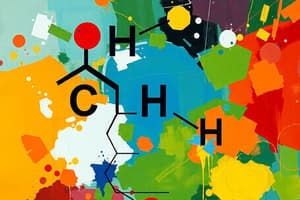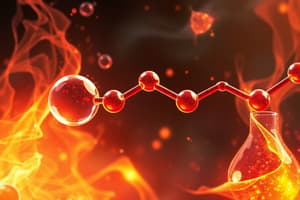Podcast
Questions and Answers
What is the function of the carbonyl group in carbonyl compounds?
What is the function of the carbonyl group in carbonyl compounds?
- It acts as an electron donating group
- It only affects the acidity of β-hydrogens
- It acts as an electron withdrawing group (correct)
- It has no effect on the acidity of the hydrogen atoms
What is the reason for the acidity of α-hydrogens in carbonyl compounds?
What is the reason for the acidity of α-hydrogens in carbonyl compounds?
- Due to the inductive effect of the carbonyl carbon
- Due to the presence of a negatively charged oxygen atom
- Due to the presence of a highly electronegative oxygen atom (correct)
- Due to the presence of a positively charged carbon atom
What is the name given to the carbanions stabilized by the carbonyl carbon?
What is the name given to the carbanions stabilized by the carbonyl carbon?
- Carboxylate anion
- Keto anion
- Alkoxide anion
- Enolate anion (correct)
Which of the following is a common base used in reactions involving carbonyl compounds?
Which of the following is a common base used in reactions involving carbonyl compounds?
Why are aldehydes stronger acids than ketones?
Why are aldehydes stronger acids than ketones?
What is the reason for the stabilization of the enolate ion?
What is the reason for the stabilization of the enolate ion?
What is the effect of the carbonyl group on the acidity of α-hydrogens?
What is the effect of the carbonyl group on the acidity of α-hydrogens?
Which of the following is NOT a characteristic of carbanions formed by ionization of α-hydrogens?
Which of the following is NOT a characteristic of carbanions formed by ionization of α-hydrogens?
What is the role of the carbonyl group in the aldol reaction?
What is the role of the carbonyl group in the aldol reaction?
What is the intermediate formed in Step 1 of the aldol reaction?
What is the intermediate formed in Step 1 of the aldol reaction?
What is the final product of the aldol reaction?
What is the final product of the aldol reaction?
What is the role of the hydroxide ion in Step 1 of the aldol reaction?
What is the role of the hydroxide ion in Step 1 of the aldol reaction?
What is the key reactive intermediate in acid-catalyzed aldol condensations?
What is the key reactive intermediate in acid-catalyzed aldol condensations?
What is the role of the protonated ketone in acid-catalyzed aldol condensations?
What is the role of the protonated ketone in acid-catalyzed aldol condensations?
What is the product of the acid-catalyzed aldol condensation?
What is the product of the acid-catalyzed aldol condensation?
What is the role of the enol in acid-catalyzed aldol condensations?
What is the role of the enol in acid-catalyzed aldol condensations?
What is the reactant in the reaction that produces 1,1-diphenylethene?
What is the reactant in the reaction that produces 1,1-diphenylethene?
What is the role of triphenylphosphine in the reaction?
What is the role of triphenylphosphine in the reaction?
What is the characteristic of phosphorus ylides?
What is the characteristic of phosphorus ylides?
What is the product of the reaction between benzaldehyde and methylenetriphenylphosphorane?
What is the product of the reaction between benzaldehyde and methylenetriphenylphosphorane?
What is the condition required for the reaction to occur?
What is the condition required for the reaction to occur?
What is the significance of the carbon-carbon double bond in the reaction?
What is the significance of the carbon-carbon double bond in the reaction?
What is the reactant that reacts with triphenylphosphine to form a ylide?
What is the reactant that reacts with triphenylphosphine to form a ylide?
What is the product of the reaction between methylenetriphenylphosphorane and benzaldehyde?
What is the product of the reaction between methylenetriphenylphosphorane and benzaldehyde?
What is the reactant used to synthesize n-Butyl alcohol and 2-Ethyl-1-hexanol on an industrial scale?
What is the reactant used to synthesize n-Butyl alcohol and 2-Ethyl-1-hexanol on an industrial scale?
What is the catalyst used in the synthesis of 2-Ethyl-1-hexanol?
What is the catalyst used in the synthesis of 2-Ethyl-1-hexanol?
What is the type of reagent used in the synthesis of unsaturated alcohols?
What is the type of reagent used in the synthesis of unsaturated alcohols?
What is the product of the reaction of acetaldehyde and hydrogen in the presence of a catalyst?
What is the product of the reaction of acetaldehyde and hydrogen in the presence of a catalyst?
What is the role of the catalyst in the synthesis of n-Butyl alcohol?
What is the role of the catalyst in the synthesis of n-Butyl alcohol?
What is the intermediate product formed in the synthesis of 2-Ethyl-1-hexanol?
What is the intermediate product formed in the synthesis of 2-Ethyl-1-hexanol?
What is the purpose of using a chemoselective reagent in the synthesis of unsaturated alcohols?
What is the purpose of using a chemoselective reagent in the synthesis of unsaturated alcohols?
What is the catalyst used in the synthesis of n-Butyl alcohol?
What is the catalyst used in the synthesis of n-Butyl alcohol?
What is the purpose of using 2-oxazoline in the synthesis of substituted esters?
What is the purpose of using 2-oxazoline in the synthesis of substituted esters?
What is the outcome of treating the 2-oxazoline with n-butyllithium?
What is the outcome of treating the 2-oxazoline with n-butyllithium?
What is the reason behind the synthesis of substituted esters depending on the ease of formation and hydrolysis of 2-oxazolines?
What is the reason behind the synthesis of substituted esters depending on the ease of formation and hydrolysis of 2-oxazolines?
What is the product of the reaction between a primary amine and a carbonyl compound?
What is the product of the reaction between a primary amine and a carbonyl compound?
What is the orientation of the elimination reaction in the formation of an imine?
What is the orientation of the elimination reaction in the formation of an imine?
What happens to the enamine if it is formed initially in the reaction between a primary amine and a carbonyl compound?
What happens to the enamine if it is formed initially in the reaction between a primary amine and a carbonyl compound?
What is the difference between the reaction of a primary amine and a secondary amine with a carbonyl compound?
What is the difference between the reaction of a primary amine and a secondary amine with a carbonyl compound?
What is the purpose of using enamines in organic synthesis?
What is the purpose of using enamines in organic synthesis?
Study Notes
Carbonyl Group and Acidity
- The carbonyl group strengthens the acidity of hydrogen atoms attached to the α-carbon due to the presence of a highly electronegative oxygen atom.
- The presence of a base with a carbonyl compound that possesses an α-hydrogen leads to ionization of the latter, resulting in a carbanion.
- The carbanion is a resonance hybrid of two structures, made possible by the participation of the carbonyl group.
Enolate Anions
- Carbanions stabilized by a carbonyl carbon are known as enolate anions, which can exist in both keto and enol forms.
- The inductive effect of the positively polarized carbonyl carbon strongly stabilizes the negative charge at the α-position.
- Aldehydes are stronger acids than ketones because their carbonyl carbon bears a larger partial positive charge.
Aldol Reaction
- The aldol reaction involves the formation of a carbanion, which then attacks a carbonyl group, followed by protonation to form a β-hydroxyaldehyde.
- The carbonyl group plays two roles in this reaction: it provides the unsaturated linkage for the addition to occur, and it makes the α-hydrogen acidic enough for carbanion formation.
- The reaction can be illustrated for various compounds, such as propionaldehyde, phenylacetaldehyde, acetophenone, and cyclohexanone.
Acid-Catalyzed Aldol Condensations
- Acid-catalyzed aldol condensations typically give α,β-unsaturated carbonyl compounds as products, with the addition product not being isolated.
- The conjugate acid of the aldehyde or ketone is a key reactive intermediate, serving as a source of the enol and as the electrophilic species in the reaction.
Synthesis of Unsaturated Alcohols
- Unsaturated alcohols can be synthesized using a reagent that reduces only the carbonyl group, leaving the carbon-carbon double bond intact, such as sodium borohydride (NaBH4).
- This is an example of a chemoselective reagent, which selectively attacks one of several different functional groups.
Protection of Carboxyl Groups
- The reaction of a phosphorus ylide with an aldehyde or ketone can be used to protect the carboxyl group, with the position of the carbon-carbon double bond being maintained.
- The phosphorus ylides have hybrid structures, with the negative charge on carbon and the positive charge on phosphorus.
Alkylation of Carbonyl Compounds via Enamines
- Amines react with carbonyl compounds by nucleophilic addition, with the initial addition product undergoing dehydration to form a compound containing a carbon-nitrogen double bond (an imine).
- If the amine is primary, the preferred product is the imine, while if the amine is secondary, the product is an enamine.
Studying That Suits You
Use AI to generate personalized quizzes and flashcards to suit your learning preferences.
Description
The carbonyl group's influence on the acidity of hydrogen atoms attached to the α-carbon, and its role in ionization. Learn about the resonance hybrid structures formed in this process.




